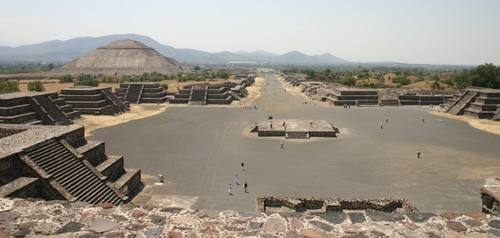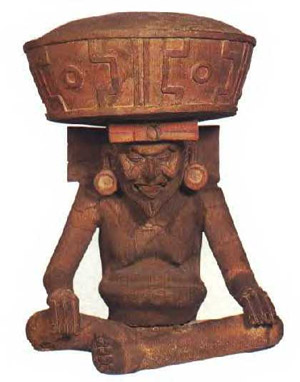|
The Oldest Pyramid on Earth?
from PhilipCoppens Website
In a suburb of Mexico City sits a circular pyramid, partially covered by a lava field from the Xitle volcano. The pyramid of Cuicuilco rises to no more than 18 meters in height, though measures 120 meters in diameter. Excavated for the first time by Mexican archaeologist Manuel Gamio in 1917, the original height is estimated to have been 27 meters.
Gamio discovered four galleries and a central staircase that went to the summit. The site was been dated to the 1st century AD, and is believed to have been the oldest pyramid structure in the New World – predating Teotihuacan, north of Mexico City. Cuicuilco may also have been the oldest city in the Valley of Mexico and was roughly contemporary with, and possibly interacting with, the Olmec civilization of the Gulf Coast.
This already makes it highly important.
Still, it is not a true pyramid, being rather a truncated conical
mound, with a clay-and-rubble core faced with river boulders and
basalt slabs. But despite not adhering to the “true” pyramid shape,
it nevertheless is as controversial – if not more so – than several
other true pyramids.
National Geographic discussed Cuicuilco
in 1923 (no. 44). In the 1922, Byron Cummings of the
University of Arizona became interested in the structure when he
learned that a geologist named George E. Hyde had estimated
the age of the flow, the Pedregal lava flow, as being 7000 years
old. This resulted in an obvious contradiction: how could a pyramid
be 5000 years younger than the lava covering it? Cummings decided to confirm or deny and found 18 feet of sediment and ashes between the bottom of the Pedregal layer and the pavement surrounding the temple pyramid.
He came up with 8500 years as the timeframe how long it would require to accumulate. If correct, it would make Cuilcuilco by far the oldest building in Mexico – and the oldest pyramid in the world. But immediately, there was a problem, for the eruption of the volcano had never been dated to 6050 BC, but considered to be after 450 BC. It is clearly something was wrong, and the likeliest person to be wrong, was Cummings.
Rather surprisingly, his conclusions were not immediately attacked or considered unlikely.
Teotihuacan Cummings worked before the invention of carbon-dating and hence he was only able to estimate, not date, the age of the sediments. In fact, rather than 8500 years old, he actually gave a timeframe of 8500 to 30,000 Before Present (BP).
Nevertheless, in 1966, even Hapgood conceded that these lava flows were only about 2000 years old:
Still, Hapgood could be forgiven for not
having taken into account the first series of carbon-dating results,
which were only done in 1963. However, today, sometimes the age of
the pyramid continues to be described as controversial, despite a
second series of carbon-dating that was accomplished in 1994, and
which confirmed the conservative date.
Though the dating of Cuicuilco has been
ironed out, it was but one episode in a long list of anomalies that
have attached themselves to the pyramid. The Spanish physician
Hernandez, sent to Mexico by order of (King) Philip II, visited Cuicuilco and wrote to his sovereign about having found the bones of
large beasts, along with those of “men” in excess of five meters
tall. Natives expressed a belief that Cuicuilco’s enigmatic
structure had been built by
giants. Whereas the bones of these
giants seem to have been lost, the beasts are now believed to have
been the toxodon and the titanothere. Furthermore, while Cummings was carrying out his excavations in the early 1920s, the site was apparently visited one night by an unidentified flying light that hovered over the ruins before speeding off into the distance.
Huehueteotl The archaeological evidence showed that the city was abandoned around 150 to 200 AD, after the eruption of Xitle. Pottery and other evidence suggest that refugees from the volcanic disaster migrated north and became part of the population pool of Teotihuacan, near the northern shore of Lake Texcoco. It is here that Mexico’s greatest pyramid adventure, to rival the Gizeh pyramid complex, would be accomplished in due course.
Although known mostly in the valley around Mexico City, images and iconography depicting Huehuetéotl have been found at other archaeological sites across Mesoamerica, such as in the Gulf region, western Mexico, Protoclassic-era sites in the Guatemalan highlands such as Kaminaljuyú and Late-Postclassic sites on the northern Yucatán Peninsula.
At the same time, the king was required to perform certain rituals that were meant to align the intentions of this world with that of the pantheon.
Xiuhtecuhtli Whereas a lot of focus was obviously placed on the “New Fire”, it seems that there was also a sacred precinct for the “Old Fire”, linked with the “Old God”, and that this site may have been Cuicuilco.
Mythology and archaeology thus are
aligned.
|



